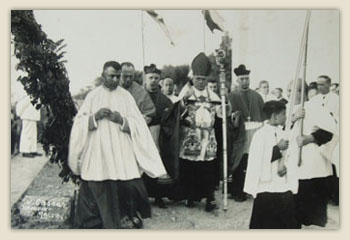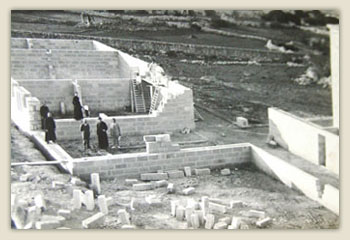| |
On the occasion of
the laying of the Foundation Stone of St.
Agatha’s, the motherhouse of our Society - 3
October 1932 - we are publishing this extract
from the 1933 Almanac, containing the beautiful
speech given by Joseph De Piro on this occasion.
 |
"As everybody knows - Your Excellency -
God's works and not ours, bear contrariety
as a sign and as an ornament. In the work we
have before us and in our hands, for the
span of about fourteen years, there were so
many difficulties one after the other, that
they could have tired every man. But since
it was God who set to work at the task, His
servants never lacked courage. Moreover,
like a firm and sweet breeze God's spirit
which always accompanied the difficulty blew
in the sails of our poor boat, troubled by
the waves.
And therefore all those who could recognize
all the circumstances, whether very close or
at distance which during such a long time
led to today's solemn occurrence, can
understand quickly and well the great
happiness which inhabits our soul at this
instance. We have arrived at the longed for
right; we can, in God's name raise our
voice, as we in fact do, to invite Your Rev.
Excellency to pray and call down from heaven
your choosing blessing On the Foundation
Stone of this edifice. This Edifice will
receive those who, with a generous heart
befitting their youth, accepted the
invitation they heard from on high to devout
themselves to spread Christ's kingdom on
earth through their work. Yes, here these
youths are prepared to be able to obey the
order of the Lord of the harvest. "Euntes
docete omnes gentes." Go and teach all
peoples. "Praedicate Evangelium omni
creaturae," preach the Gospel to all
creatures.
"Go and teach all nations." It is here, Rev.
Excellency, that we quickly feel sentiment
of humiliation and confusion when we start
to think about the greatness of the need and
the small amount that our work, still in its
beginning, can offer- 1700 million, Your Rev
E., are today the inhabitants of the world.
Out of these 1700 million, a 1000 million,
that is much more than half of them, are
still expecting the blessing of divine
redemption; they still do not know anything
about our Redeemer, Their ears have never
heard the sweet name of Jesus who, because
of the work of Paul of Tarsus has been
ringing on our lips for two thousand years.
Therefore when we compare such a large
number to our small fold for which today we
are beginning this building, no one has to
wonder if our senses, the mind and heart
feel full of confusion. But, to say the
truth; if the gospel event of the widow's
mite encourages us, on the other hand we
look upwards and put our hope in him who is
Our most beloved Father because, when God is
building, those who build the walls do not
labour in vain. We find another consolation
in the thought
 |
full of
truth that God's power which made everything
out of nothing and the power of the God Man
who fed thousands of people from five
loaves, has never changed and is still there
for ever. And the sign of the cross which
Your Rev. E. Puts today on this Foundation
Stone, You as a representative of the Vicar
of Christ, as Christ among us, this sign
descends also like ointment with balm on all
those pertaining to our Missionary
Institute; it makes them grow in the spirit
of Paul their Father; it makes their hearts
similar to his because, as the Chrysostom
says, the heart of Paul is the heart of
Christ. Then he makes them grow more and
more in number so that, in the extensive
missionary work, in the infinite enterprise
for the salvation of the pagan world, even
they have their share as soon as possible.
This was the living wish of the holy Pope
Pius X while he blessed the beginning of the
Institute. This is the ardent wish of the
reigning Pontiff, Pope Pius XI, the
Missionary Pope, whenever he repeats his
blessing on us. This is the object so much
longed for by us. Here finally we would be
able to say that we have heard and fulfilled
the commandment of Christ, "go and teach."
San Pawl: Almanakk tal-Istitut tal-Missjoni,
1933, trans., by Fr Frans Ferriggi, pp.
407-420.
Click here to read the
full speech
|
|